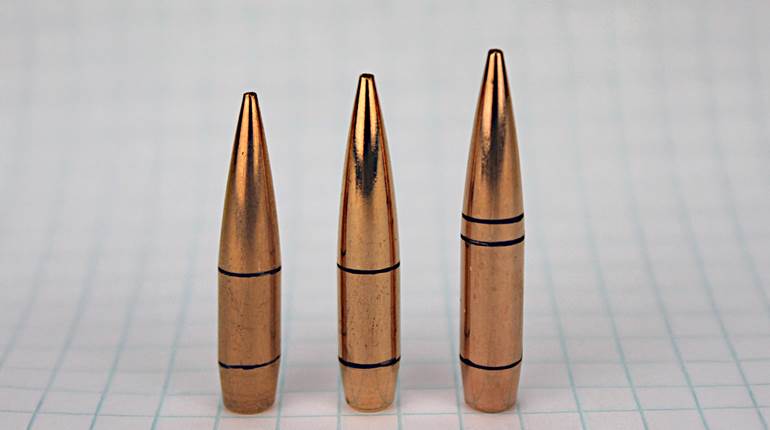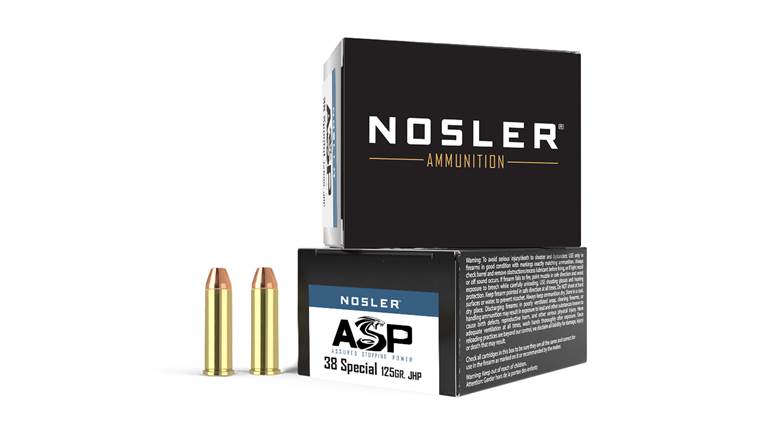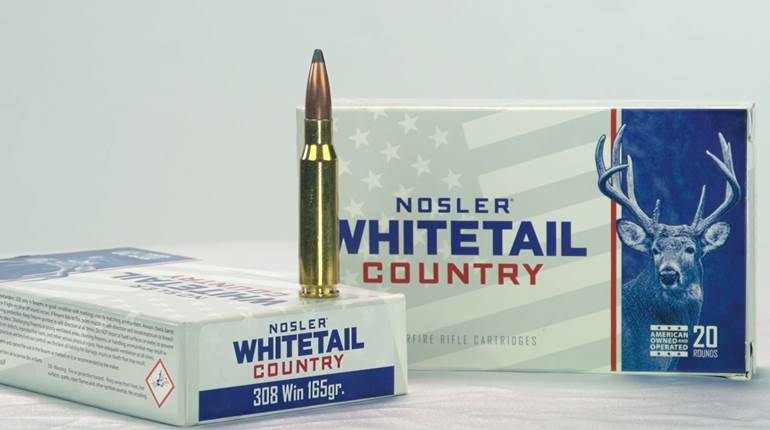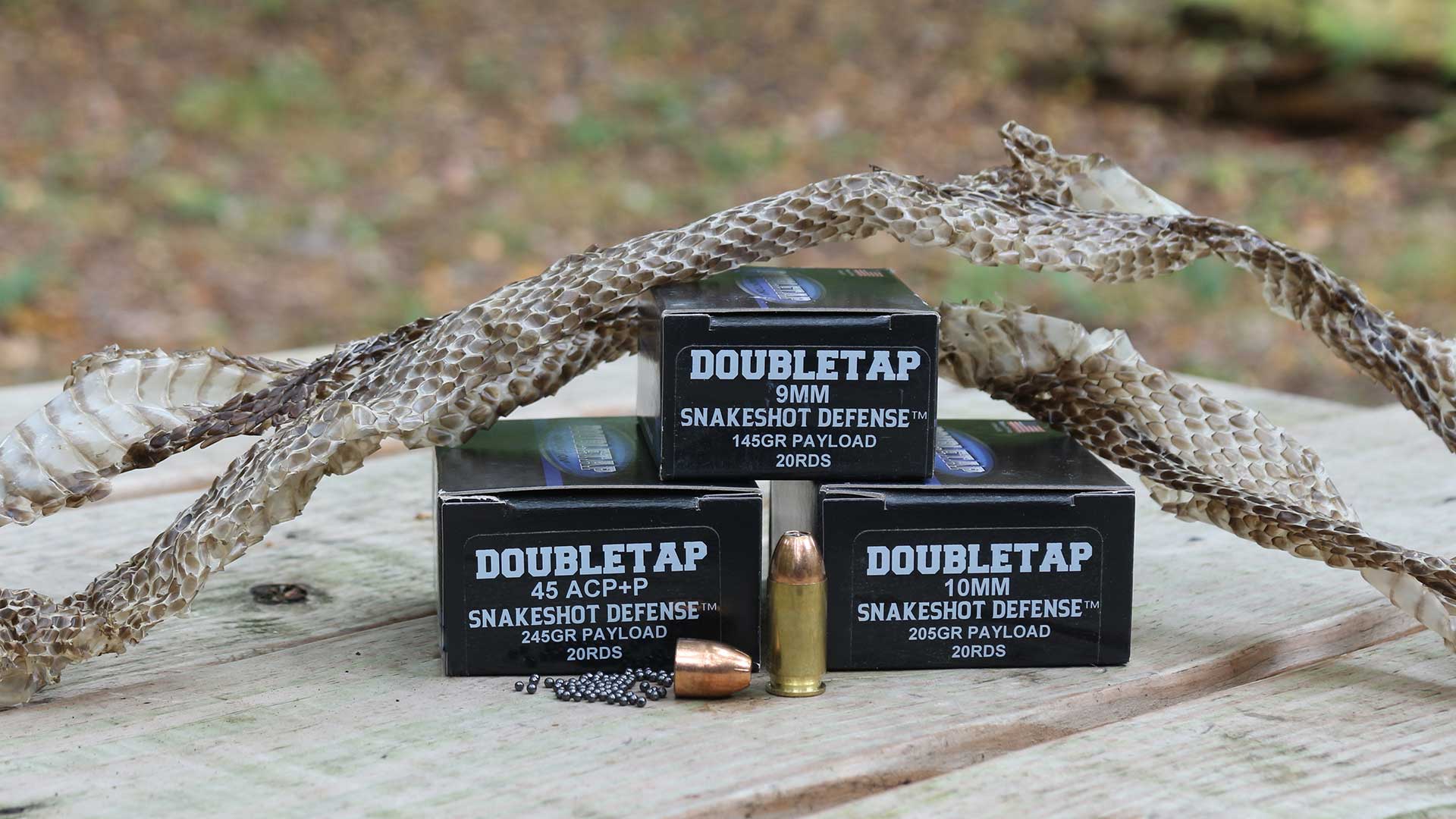
The 30 Nosler cartridge delivers better ballistics than the .300 Win. Mag. out of an unbelted case, and fits into .30-’06 Sprg.-length actions. The Nosler Model 48 Heritage shown here is topped with a Leupold VX-6 2-12X 42 mm riflescope.
More than one human has observed that the more things change, the more they stay the same. This phenomenon can be seen not only in remakes of Hollywood shoot-’em-ups, such as “The Magnificent Seven,” but in firearms and cartridges as well. One example from the past, the 8 mm Lebel, was the original smokeless military cartridge. In the few years that followed its 1886 debut, several other countries came up with their own 8 mm military cartridges. They included what came to be known as the 8x57 mm Mauser, which was the basis for umpteen zillion other cartridges, including the .30-’06 Sprg.
Around 1913, a firearm designer named Charles Newton designed (or co-designed) a .30-cal. cartridge for Fred Adolph, an upstate New York gunsmith originally from Germany. Called the .30 Adolph Express, the cartridge was designed to fit and function through the magazines of 1898 Mausers and, especially, M1903 Springfield rifles, but Adolph’s business floundered with the onset of World War I. Newton then started his own rifle company, renaming the cartridge the .30 Newton, which remained popular enough for ammunition to be produced by Western Cartridge Co. until the beginning of World War II.
Just about a century after its birth, the .30 Newton has re-appeared in the form of the 30 Nosler, and for much the same purpose—zippier muzzle velocities in bolt-actions designed around the .30-’06 Sprg. While the overall dimensions of the 30 Nosler case are slightly larger than the .30 Newton’s, the two cartridges are essentially the same solution to the same problem. However, in the 21st century, the platform isn’t the 1903 Springfield but the Nosler Model 48 bolt action, also just long enough for .30-’06-length cartridges. (It’s also not much of a coincidence that Nosler is a German name—Fred Adolph was far from the first or last American of German ancestry to influence our hunting rifles.)
As the .30 Newton ascended to the cartridge cemetery in the sky, several belted .30s appeared designed to fit in .30-’06 Sprg. magazines. Most were wildcats, but Winchester’s factory version soon became the most popular .30-cal. magnum on earth. The .300 Winchester Magnum appeared in 1963, in the rifle that would become known as the pre-’64 Model 70 Winchester. The pre-’64 also came factory-chambered in the .300 and .375 Holland & Holland magnums, so the .300 Win. Mag. really didn’t need to fit in a .30-’06 Sprg.-length magazine. But at the time “war surplus” 1903 Springfields could be purchased for a fraction of the price of a Model 70 and cheaply converted to handle the new cartridge. Winchester recognized this and designed the new cartridge to fit in .30-’06 Sprg.-length actions—half a century after the 1903 Springfield and the .30-’06 Sprg. had influenced the design of the .30 Adolf/Newton.

Despite its popularity, however, the .300 Win. Mag. was, in the estimation of many shooters, far from perfect. In part that was, ironically, because of its self-imposed overall-length limitation, which meant that the neck had to be relatively short. In addition, the belted case, which was originally designed for sure headspacing of minimally shouldered cartridges, was superfluous in the broad-shouldered .300 Win. Mag. Some shooters even believed the belt interfered with smooth feeding, despite thousands of slick-feeding .300 H&H Mag. rifles. Eventually some people started experimenting with belt-free brass, essentially reinventing the .30 Newton, giving birth to the 30 Nosler cartridge.

The new cartridge is also similar to the .300 Dakota, which has never been very popular, in part because of difficulties in purchasing ammunition and brass—a problem endemic to many proprietary cartridges. But Nosler not only has a long working relationship with Norma (which manufactures most Nosler cases and even some Nosler ammunition) but a couple of years ago added the brass manufacturer Silver State Armory to what is starting to become the Nosler empire. In fact, Nosler often offers both ammunition and brass for cartridges infrequently available from their original designers and manufacturers. Consequently, both ammunition and brass for Nosler’s two previously released cartridges, the 26 and 28, have been consistently available from several retailers, including Nosler’s own Shooter’s Pro Shop. The 30 Nosler uses exactly the same parent case (.404 Jeffery) as the 26 and 28 Noslers, so it wouldn’t be astonishing to discover the 30 had been part of the plan from the beginning.
One of the points of any beltless magnum is more case capacity than belted brass, due to a larger-diameter case body. However, propellant capacity also depends on case wall thickness, which can vary from brand to brand. So far, there’s only one brand of 30 Nosler brass, and after weighing 10 pieces I found them to average 282 grs. With a 180-gr. Nosler Ballistic Tip seated to the listed overall cartridge length of 3.340"—exactly the same as the SAAMI maximum length of the .30-’06 Sprg. and .300 Win. Mag.—an average case held 88.6 grs. of water. I did not use the common method of measuring case capacity by filling them to the mouth, since a seated bullet will occupy some of that space. Also, I used fired cases, since that results in a more accurate measurement than if using new brass when paired with a specific rifle’s chamber. Of course there is also the fact that different brands and individual pieces of brass can vary by weight. For instance, my loading room contains six brands of fired .300 Win. Mag. cases. Of those, Federal, Hornady, Remington and Winchester cases averaged around 250 grs., with a few at 240 grs. and a few close to 260 grs. A Federal case weighing 250 grs. held 79.2 grs. of water with a 180-gr. Ballistic Tip seated to 3.340", about 12 percent less than the 30 Nosler.
But by far the lightest .300 Win. Mag. cases were Norma and Nosler, averaging around 220 grs., considerably less than fired 30 Nosler cases. Consequently, their water capacity was almost 5 grs. more than the other brands of .300 Win. Mag. cases, and only about 5 percent less than that of the 30 Nosler.
This may seem trivial, but to a certain extent recent hunting cartridge development has been trivial, especially when compared to advances in bullets and propellants—but triviality doesn’t stop riflemen from endlessly “discussing” each point. One point is that potential velocity in cartridges of the same caliber, all else being equal, changes at about one-quarter the amount of powder capacity.
A good example compares the .300 Remington Ultra Magnum (RUM) and .308 Winchester. The .300 RUM has just about twice the propellant capacity of the .308 Win., but if velocity correlated directly to propellant capacity, the muzzle velocity of 180-gr. bullets from the .300 RUM would be greater than 5000 f.p.s.—instead it’s in the neighborhood of 3300 f.p.s., matching the one-quarter ratio very closely.
As a result, an increase of 5 percent in powder space only increases potential muzzle velocity about 1.25 percent, or 37.5 f.p.s., more than a cartridge/load attaining 3000 f.p.s. But a 12 percent gain in powder capacity results in a potential velocity increase of 3 percent, which is 90 f.p.s. faster than 3000 f.p.s. So how much velocity the 30 Nosler gains over the .300 Win. Mag. depends to a certain extent on the brand of .300 brass.
However, the 30 Nosler has another, perhaps more tangible advantage, especially with the recent proliferation of sleeker bullets. The .300 Win. Mag. case sometimes makes seating long-ogive bullets a problem. The 30 Nosler shifts more of its powder capacity to the rear, resulting in a somewhat longer neck on a slightly shorter case body, allowing the use of long-ogive bullets, such as the Nosler AccuBond Long Range.

The success of any new factory cartridge still depends, to a certain extent, on other suitable actions. One reason the Winchester Super Short Magnums are almost defunct is that they wouldn’t function in commonly available actions, not only preventing other manufacturers from chambering the WSSMs, but shooters from re-barreling their rifles to WSSMs. One minor problem with the .300 Dakota is a rim diameter slightly larger than that of standard belted cases, making it necessary to alter the bolt faces of most commercial actions. The beauty of the 30 Nosler case design is that its rim diameter is nearly identical to that of the .300 Win. Mag. So, in theory, any action that can handle the .300 Win. Mag. should be capable of being chambered for the 30 Nosler cartridge.
Nosler’s family of proprietary cartridges continues to expand, most recently with the 33 and 22 Noslers. So while the 30 Nosler isn’t the newest addition, it might end up as the most popular. Why? Because .30-cal. magnums are generally considered the best all-around compromise for hunting the world’s non-dangerous big game. That’s one reason almost every brand of bolt-action rifle is chambered for the .300 Win. Mag. It would be difficult for any newer .30-cal. cartridge to approach that sort of popularity, but for hunters who really hate belted brass, the 30 Nosler may be the answer.

I tested loads in one of Nosler’s Heritage models with a traditionally finished and checkered walnut stock, but bedded the same way as synthetic-stocked Nosler rifles, with action-screw pillars and a free-floated barrel. Hunters tend to think walnut stocks are much heavier than synthetics, but this particular walnut stock weighs only 2.5 ozs. more than the synthetic on my 26 Nosler Liberty rifle. With a 14-oz. 3-9X 40 mm Burris C4 Plus riflescope in Talley steel rings, the 30 Nosler Heritage weighed 9 lbs. 2 ozs., pretty average for factory .300 magnums with 26" barrels.
At the time of the test, only one type of Nosler Trophy Grade factory loading was available, and it was loaded with the 210-gr. AccuBond Long Range bullet. From the test rifle’s 26" barrel this load averaged 2891 f.p.s., and (like the 26 and 28 Nosler rifles previously tested) easily met Nosler’s one-m.o.a. accuracy guarantee for three-shot groups at 100 yds. with Nosler ammunition.
However, the American Rifleman protocol is five, five-shot groups at 100 yds., and five-shot groups average about one-third larger than three-shot groups, even in super-accurate benchrest rifles. The Heritage was no exception, but the test rifle shot somewhat more accurately with two handloads using the propellants listed as most accurate in Nosler’s data, 76.0 grs. of Alliant Reloder 22 with 180-gr. Ballistic Tips and 73.0 grs. of IMR7828 with 200-gr. AccuBonds. (To some people it might seem inappropriate to test 180-gr. Ballistic Tips in a .30-cal. magnum, but big-game Ballistic Tips have been beefed up during the 30-plus years since they were introduced.) The 180-gr. .30 made for the past few years features a very heavy jacket, making up two-thirds of its total weight, providing great penetration and almost as much retained weight as Nosler Partitions. A local friend prefers them for elk hunting with his .300 Wby. Mag., and after shooting a cow facing him, found the expanded bullet in one of the hams.
The good range results didn’t surprise me. Nosler’s actions are cast in Oregon, then the final dimensions are accurately machined at Nosler’s factory, so in essence they’re “blueprinted” during production, not corrected afterward. The barrels are from Pac-Nor, another Oregon company with a fine reputation, and the barreled actions are correctly bedded in the stocks. Why wouldn’t they shoot well?
 In fact, the only real criticism I had of the rifle is the sharply checkered bolt knob, with all the diamonds precisely pointed up. My hands are pretty broad but my fingers aren’t overly long, and during the first shot the nice, sharp checkering tore a half-inch gash on top of the first joint of my trigger finger, despite my normal practice of placing only the pad of my fingertip on the trigger. My 26 Nosler Liberty’s bolt knob has the same checkering pattern, but the diamonds are flat-topped—and of course the 30 Nosler recoils more than the 26.
In fact, the only real criticism I had of the rifle is the sharply checkered bolt knob, with all the diamonds precisely pointed up. My hands are pretty broad but my fingers aren’t overly long, and during the first shot the nice, sharp checkering tore a half-inch gash on top of the first joint of my trigger finger, despite my normal practice of placing only the pad of my fingertip on the trigger. My 26 Nosler Liberty’s bolt knob has the same checkering pattern, but the diamonds are flat-topped—and of course the 30 Nosler recoils more than the 26.
The problem was solved by wearing a thin-leather shooting glove on my right hand, but a checkered knob is a semi-useless tradition. The knob is meant to rotate in the shooter’s hand, the reason the pre-’64 Winchester Model 70 gained an ultra-reliable reputation with a perfectly smooth knob. Light checkering doesn’t hurt, but really sharp checkering can hurt, especially on a harder-kicking rifle.
The world is obviously filled with .30-cal. magnums, but the 30 Nosler seems to offer several advantages for those hunters looking for every advantage in their hunting rifles. Just about every present “magnum” action can be chambered for it, and while the feed rails or magazine may require tweaking, the bolt face won’t need to be opened up. It’s slightly shorter, fatter and longer-necked than the .300 Win. Mag., for increased velocities and more flexible bullet seating.
Nosler brass is of very good quality and consistency, both in weight and neck thickness. Judging from the 26 and 28 Noslers, ammunition will be relatively easily available—and while costing more than .30-’06s from Walmart, price isn’t that big a deal to many hunters seeking top performance on big game such as elk, moose and African plains game. The same hunters also don’t have any objections to paying for quality rifles, with great barrels and properly-bedded stocks.
Plus, in the end, the Nosler family doesn’t care all that much about whether its cartridge becomes a widely popular .30-cal. magnum—though of course that would be nice. What it’s interested in is designing and building hunting rifles for serious hunters at competitive prices.
And in that it’s succeeded.







































